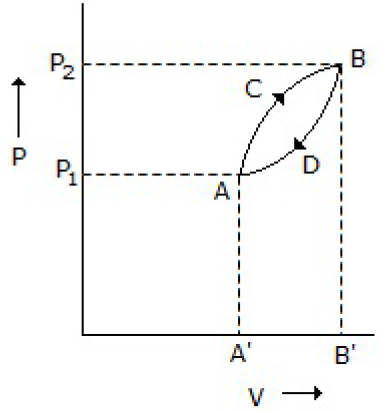The gas law (PV = RT) is true for an __________ change.
Isothermal
Adiabatic
Both (A) & (B)
Neither (A) nor (B)
Correct Answer :
C. Both (A) & (B)
Related Questions
The enthalpy change when ammonia gas is dissolved in water is called the heat of
Solution
Formation
Dilution
Combustion
The unit of fugacity is the same as that of the
Pressure
Temperature
Volume
Molar concentration
Clapeyron Equation deals with the
Rate of change of vapour pressure with temperature
Effect of an inert gas on vapour pressure
Calculation of ΔF for spontaneous phase change
Temperature dependence of heat of phase transition
Isobaric process means a constant process.
Temperature
Pressure
Volume
Entropy
Which of the following is not an extensive property?
Free energy
Entropy
Refractive index
None of these
When liquid and vapour phases of one component system are in equilibrium (at a given temperature and pressure), the molar free energy is
More in vapour phase
More in liquid phase
Same in both the phases
Replaced by chemical potential which is more in vapour phase
Keeping the pressure constant, to double the volume of a given mass of an ideal gas at 27°C, the temperature should be raised to __________ °C.
270
327
300
540
An isentropic process is carried out at constant
Volume
Pressure
Temperature
All (A), (B) and (C)
A thermodynamic system is taken from state A to B along ACB and is brought back to A along BDA as shown below in the P-V diagram. The net work done during the complete cycle is given by the area covered by

P1ACBP2P1
ACBB1A1A
ACBDA
ADBB1A1A
A gas performs the maximum work, when it expands
Non-uniformly
Adiabatically
Isobarically
Isothermally
What is the ratio of adiabatic compressibility to isothermal compressibility?
1
< 1
> 1
>> 1
Refrigeration cycle
Violates second law of thermodynamics
Involves transfer of heat from low temperature to high temperature
Both (A) and (B)
Neither (A) nor (B)
In case of vapour compression refrigeration system, elevating the evaporator temperature (keeping the condenser temperature constant) results in
Enhanced COP
Decreased COP
No change in the value of COP
Increased or decreased COP; depending upon the type of refrigerant
Which of the following is an extensive property of a system?
Heat capacity
Molal heat capacity
Pressure
Concentration
The value of Cp & Cv respectively for monatomic gases in Kcal/kg Mole.°K are
5 & 3
3.987 & 1.987
1.987 & 0.66
0.66 & 1.987
What is the value of ln y (where y = activity co-efficient) for ideal gases?
Zero
Unity
Infinity
Negative
All gases above its inversion temperature, in a throttling process will show
A heating effect
No change in temperature
A cooling effect
Either (A) or (C)
The expression, nRT ln(P1/P2), is for the __________of an ideal gas.
Compressibility
Work done under adiabatic condition
Work done under isothermal condition
Co-efficient of thermal expansion
Fugacity of a component in an ideal gas mixture is equal to the partial pressure of that component in the mixture. The fugacity of each component in a stable homogeneous solution at constant pressure and temperature __________ as its mole fraction increases.
Decreases
Decreases exponentially
Increases
Remain constant
At triple point (for one component system), vapour pressure of solid as compared to that of liquid will be
More
Less
Same
More or less; depending on the system
The necessary condition for phase equilibrium in a multiphase system of N components is that the
Chemical potentials of a given component should be equal in all phases
Chemical potentials of all components should be same in a particular phase
Sum of the chemical potentials of any given component in all the phases should be the same
None of these
Isotherm on an enthalpy-concentration diagram, for an ideal solution will be a
Straight line
Sine curve
Parabola
Hyperbola
The value of Joule-Thomson co-efficient, in case where cooling occurs after the throttling process is
0
∞
+ve
-ve
Melting of wax is accompanied with __________ in entropy.
Increase
Decrease
No change
None of these
In the ammonia synthesis reaction, N2 + 3H2 2NH3 + 22.4 kcal, the formation of NH3 will be favoured by
High temperature
Low pressure
Low temperature only
Both low temperature and high pressure
For a given substance at a specified temperature, activity is __________ to fugacity.
Directly proportional
Inversely proportional
Equal
None of these
In Joule-Thomson porous plug experiment, the
Enthalpy does not remain constant
Entire apparatus is exposed to surroundings
Temperature remains constant
None of these
A gas mixture of three components is brought in contact with a dispersion of an organic phase in water. The degree of freedom of the system is
3
4
5
6
The expression for entropy change given by, ΔS = nR ln (V2/V1) + nCv ln (T2/T1) is valid for
Reversible isothermal volume change
Heating of a substance
Cooling of a substance
Simultaneous heating and expansion of an ideal gas
Dryness fraction of wet steam is defined as the ratio of mass of vapour in the mixture to the mass of mixture __________ calorimeter is not used for measuring the dryness fraction of steam.
Bomb
Separating
Bucket
Throttling
